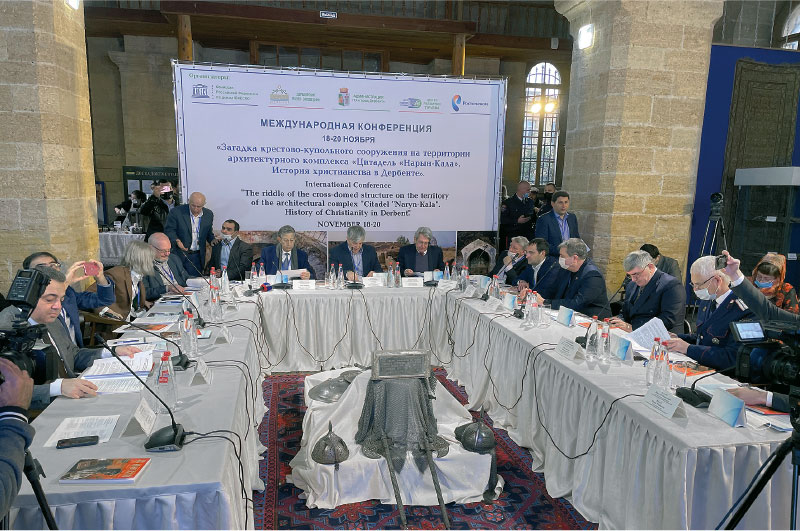
The international conference “The Mystery of the Cross-Domed Structure on the Territory of the Naryn-Kala Fortress. The History of Christianity in Derbent” took place on November 18-20 in Derbent, Republic of Dagestan. The conference was organized by the Commission of the Russian Federation for UNESCO and the administration of the City of Derbent. Participants included Hizri Abakarov, Secretary of State of the Republic of Dagestan; Grigory Ordzhonikidze, Secretary-General of the Commission of the Russian Federation for UNESCO; Mounir Bouchenaki, special advisor to UNESCO Director General Azoulay; Mikhail Piotrovsky, General Director of the State Hermitage; Leonid Kondrashev, Deputy Head of the Department of Cultural Heritage and Chief Archaeologist of Moscow; Academician Andrey Kudryavtsev; Natalia Soloveva, Deputy Director of the Institute for the History of Material Culture of the Russian Academy of Sciences as well as religious and public figures from the Republic.
The conference was held to examine the cross-domed structure discovered by Academician Andrey Kudryavtsev on the territory of the Naryn-Kala fortress, particularly to determine its former purpose and date of construction. The primary hypothesis expressed during the conference was that the ancient cross-domed object on the territory of the fortress served as a martyrium between the 5th-7th centuries.
Following an exchange of opinions, experts concluded that the structure is an early Christian religious cruciform construction, requiring a further comprehensive examination. In addition, conference participants unanimously supported the Derbent Appeal, voiced by Mikhail Piotrovsky, General Director of the State Hermitage, to create an international organization to monitor the condition of cultural and architectural monuments in the Caucasus.
The Derbent Appeal
On the soil of ancient Derbent, which preserves monuments of a host of ancient cultures, in the presence of people and organizations that have devoted their lives to the study and preservation of those monuments, and for the sake of that have gathered here today, I want to address an appeal for the uniting of efforts towards the monitoring and study of the state of monuments in the Caucasus, and especially in the south, in Transcaucasia.
The Caucasus is an amazing part of the world, where the Lord has gathered together monuments and symbols of different cultures, civilizations, eras, religions and denominations. This unique and instructive complex is the heritage of the whole world, and the whole world should not only preserve that heritage, but also learn from its example the beauty of the world’s diversity.
Part of the centuries-long history of the Caucasus is the diversity of ethnic, religious, establishment and state formations that, as we well know, come into at times inevitable conflicts that threaten not only people’s lives, but also the preservation of monuments, and that means of humanity’s memory.
Proceeding from the interests of the world community today and in the future, I propose creating an international system for monitoring the condition of these fortresses, cemeteries, places of worship, memorial places and archaeological sites, for the study and discussion of the inherited and acquired problems appertaining to them, connected both with their state of preservation and with the world’s perception of their spiritual and aesthetic significance…
